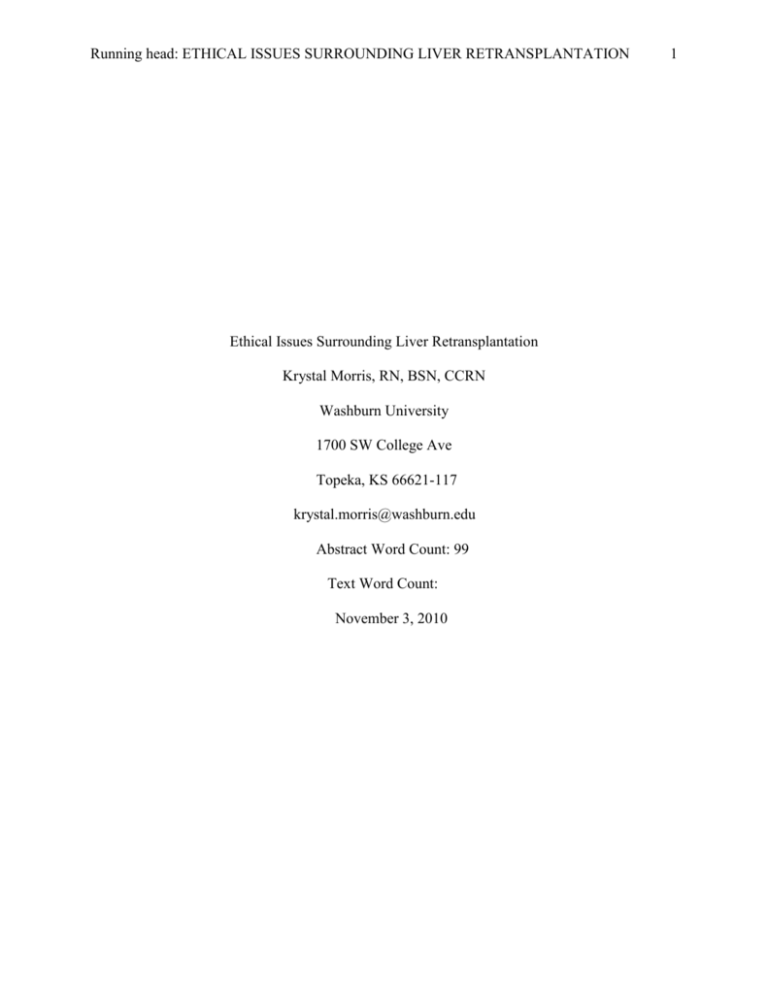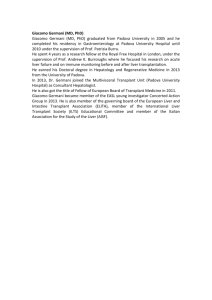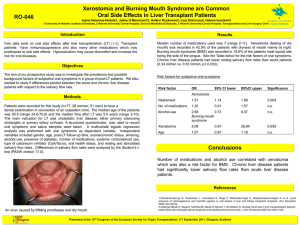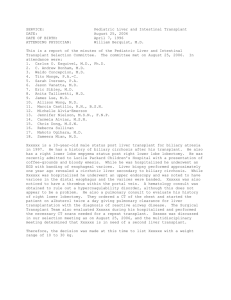Ethical Issues Surrounding Liver Retransplantation
advertisement

Running head: ETHICAL ISSUES SURROUNDING LIVER RETRANSPLANTATION Ethical Issues Surrounding Liver Retransplantation Krystal Morris, RN, BSN, CCRN Washburn University 1700 SW College Ave Topeka, KS 66621-117 krystal.morris@washburn.edu Abstract Word Count: 99 Text Word Count: November 3, 2010 1 ETHICAL ISSUES SURROUNDING LIVER RETRANSPLANTATION 2 Abstract Liver retransplantation accounts for 5 to 20% of all liver transplants performed in the United States today (1). According to the Organ Procurement and Transplantation Network, as of October 22, 2010, there are 16,026 candidates for liver transplant. Of these candidates, 554 individuals are listed as needing liver retransplantation (2). Primary graft failure, recurrence of HCV cirrhosis, hepatic artery thrombosis (4), infections postoperatively, bleeding complications, along with acute and chronic rejection episodes (7) are among the primary reasons that repeat liver transplantation occurs. This topic presents many controversial ethical, medical, and social considerations. ETHICAL ISSUES SURROUNDING LIVER RETRANSPLANTATION 3 Ethical Issues Surrounding Liver Retransplantation Introduction Liver retransplantation accounts for 5% to 20% of all liver transplants performed in the United States today (1),. In order to be a candidate for transplantation, each patient is placed on the national donor list, managed by the United Network of Organ Sharing (UNOS) which works in conjunction with the Organ Procurement and Transplantation Network (OPTN) (2). According to OPTN, as of October 22, 2010, there are 16,026 candidates for liver transplant. Of these candidates, 554 people are listed as needing liver retransplantation (3). Primary graft failure, recurrence of Hepatitis C Virus (HCV) cirrhosis, hepatic artery thrombosis (4), postoperative infections, bleeding complications, technical problems with surgery, such as biliary complications (5,6), along with acute and chronic rejection episodes (7) are among the primary reasons that repeat liver transplantation is necessary. The waiting list ranks patients based on the severity of their liver disease. Bilirubin, prothrombin time, and creatinine are utilized in a calculation that provides the transplant team with a Model of End Stage Liver Disease (MELD) score. This score ranges from 6 to 40, with higher scores placing patients as the highest priority. Each person’s score indicates the urgency for needing a liver transplant within the next three months (2). Liver retransplantation presents many controversial ethical, medical, and social considerations. Literature supporting and opposing liver retransplantation, legalities of retransplantation, and patient case reviews will be analyzed throughout the content of this text, highlighting recommendations for nursing. ETHICAL ISSUES SURROUNDING LIVER RETRANSPLANTATION 4 Discussion Supportive Literature Current literature suggests that 5% to 20% of all patients undergoing liver transplantation will require retransplantation (8). The success rate of those retransplanted is approximately 62% to 82%. Over the past decade, surgical techniques have improved, and additional research on appropriate immunosuppression therapy and donor evaluation has increased survival rates (5). In the early years of liver transplantation, technical complications of the surgery and chronic rejection from inadequate immuonsupressive drug dosages were among the primary reasons for retransplantation (1). Success of liver retransplantation has increased as an increasing number of surgeons have gained expertise (12). Proficiency comes with expertise, which in turn reduces cold ischemic times, yielding more successful transplantations (24). Hospitals performing larger volumes of transplant cases have been shown to lower the mortality risk one year following surgery (12). Additional success can be attributed to the process of care that hospitals put into place. Larger hospitals with a higher volume to transplants often have a Transplant Intensive Care Unit that specializes in the care of patients with select types of organ transplantation. With this type of implementation, nursing staff receives focused training and orientation in caring for this specialized patient population. Nurses are the primary care providers for the patient postoperatively, therefore importance is stressed on early identification of signs and symptoms of complications to aide in facilitating prompt communication with the surgical staff. Protocols and standards of practice have been set in place to assist with this process. A large metropolitan hospital in the Midwest, for example, has developed a standardized order set that is initiated in the Transplant Intensive Care Unit (TICU) for postoperative liver ETHICAL ISSUES SURROUNDING LIVER RETRANSPLANTATION 5 transplants to ensure that appropriate nursing interventions are completed, and immunosuppressive medications are properly ordered and administered. Following surgery, liver transplant patients are transferred to the TICU to receive one on one nursing care for four hours, and if necessary, longer to ensure that the nurse is able to adequately focus on the patient and communicate with collaborating physicians as necessary. Once a patient’s condition is considered stable, he or she is transferred to a Transplant Progressive Care Unit where the staff has also received an extensive transplant orientation and specialize in caring for these patients. This type of intervention can aide in the success rate of retransplantation through maintaining continuity of care through the recognition of early patient problems and by providing the necessary post- operative education to prepare the patient for the transition home and facilitating the likelihood of a successful retransplantation. Outcomes of retransplantation are associated with the indication of the surgery. Many retransplantation surgeries occur within 30 days of initial transplantation, and show an increasing number of positive results when the procedure occurs in this time frame (5). The exception to this statement is when patients are urgently retransplanted and clinically unstable prior to surgery. Improved outcomes have been noted among patients who were retransplanted due to hepatic artery thrombosis, a common indication for a repeat transplant (10). Waiting lists for transplant candidates have increased, although there has not been a significant increase in donors. Many efforts are currently being made to raise awareness about organ donation to the public. Information regarding donation has been placed on social media outlets in the past year. Among these groups includes Facebook, YouTube, and twitter. UNOS has a Facebook corporate page as well as various groups to join for those who have received a transplant, are awaiting a transplant, or have been affected in some way by a transplant (21). ETHICAL ISSUES SURROUNDING LIVER RETRANSPLANTATION 6 Social networking sites have been a growing trend over the past decade. Utilizing this type of tool could prove beneficial by targeting a larger population of individuals in regards to the current organ shortage and encourage others to become interested in organ donation. Donor history is an important factor that transplant teams analyze when making the decision to accept or deny potential liver transplant donors. Extended criteria donors (ECDs) are donors that a transplant team will accept that are often more complex cases due to advanced donor age, donation after cardiac death, and various ischemic donor injuries (23) Currently, authors are working to develop a standardized tool to serve as a donor risk screening index to assist with the determination of acceptable organs (17). Utilizing this population of donors is an attempt to increase the pool of available donors for the many candidates on the waiting list. In an attempt to expedite the decision to accept an organ, local procurement by a team other than the receiving transplant team is growing in popularity. The average cost for travel for organ procurement is approximately $30,000 (23). Transplant teams are more hesitant to make the flight on a questionable donor due to the risk that the flight presents to the crew as well as the financial obligation that is associated. Local teams have begun to take high quality digital photography of the liver once it has been procured to send to the transplant team who will make the ultimate decision if the liver is acceptable before beginning the costly process of transporting an organ (23). Opposing Literature Liver retransplantation is often the only chance for survival in patients experiencing a variety of complications leading to failure of the primary liver, also referred to as a hepatic graft in the literature. The procedure presents a greater risk of morbidity and long term survival than for persons receiving an initial transplant (1,5,11,12). Allograft failure often occurs due to the ETHICAL ISSUES SURROUNDING LIVER RETRANSPLANTATION 7 technical demands of the surgery along with pre-existing comorbities (9). Liver transplant has become the treatment of choice for many patient conditions such as primary biliary cirrhosis, alcohol and HCV related liver diseases, and Hepatocellular Carcinoma. Since retransplantation has become an option, it is the treatment of choice for more patients who meet criteria and have been placed on the waiting list. Although the number of candidates for transplantation has increased, there has not been a significant increase in the number of organ donors to meet this demand (13). Organ shortage in the United States is one of the many controversial issues surrounding liver retransplantion. When a patient receives a repeat transplant, many think it is unjust to give priority over someone who has never received a transplant (13). Currently, 554/16,026 (.035%) of those nationally listed as candidates for transplantation are listed for retransplantation. The mortality rate of patients on the initial liver transplantation is approximately 18% (24). Statistically, this numbers appears of patients awaiting retransplantation are very small, yet can raise many ethical concerns for the transplant teams, candidates for transplant, and family members Patients with Primary Biliary Cirrhosis often rank with a lower MELD score, which will lead to a longer wait time to receive a transplant. This can raise an ethical concern when patients with HCV have a higher MELD score and will receive transplantation sooner. Many patients with HCV have contracted the disease from sexual activity or drug use. Patients with alcoholic cirrhosis can become transplant candidates once they have completed the necessary rehabilitation and have been free of alcohol for at least 6 months. One could argue these particular patient situations should not have priority over patients whose lifestyles have not contributed to their liver failure. ETHICAL ISSUES SURROUNDING LIVER RETRANSPLANTATION 8 Psychosocial evaluations are part of the transplant process. In order for a patient to be listed as a candidate, social workers and transplant coordinators evaluate the support system that is in place for the patient. It is important to make sure there is a strong foundation of support, as a liver transplant is a life changing experience that will require a commitment of taking an immunosuppressive regimen, follow up laboratory work, and follow up appointments. Immunosuppressive regimens often include taking an oral anti-rejection medication two times a day. Following discharge from the hospital, patients are required to stay in the vicinity of the transplant facility for several weeks, occasionally longer, in order for laboratory work to be obtained and analyzed, to target postoperative complications early on. Patients are allowed to return home once laboratory work has stabilized, but are often required to get blood drawn weekly or biweekly for a period of time, and eventually monthly. The life change that a liver transplant brings requires a desire for success through compliance with all regimens by the patient, which is often facilitated and encouraged through their support system. Occasionally liver transplant candidates are denied due to lack of a support system to help them follow the rigorous regimen previously discussed. The ethical issue that this presents is the fairness in denying someone a life-saving transplant because they do not have a support system in place. Some individuals no longer have family ties and prefer to keep to themselves. Does this mean that they are not an appropriate candidate? Lack of a support system does not always mean that a patient will have compliance issues with a new organ, although research indicates better success rates with it in place. Although the primary goal of organ retransplantation is the optimal health of the patient, it is realistic to analyze the financial considerations behind the procedure. The high costs of retransplantation have been well documented (6,10). The cost of a retransplantation is twice that ETHICAL ISSUES SURROUNDING LIVER RETRANSPLANTATION 9 of the primary one (6). In general, patients who are retransplanted have a higher degree of illness than those receiving a primary transplant (10). Longer stays in the Intensive Care Unit can be financially demanding due to the level of care that is necessary along with the additional diagnostic testing that is involved. As of 2005, it was estimated that the cost of an adult liver transplant is approximately $146,069. If a patient requires retransplantation, the cost of a late retransplant is about $331,943, while retransplantation earlier on is $442,092 (6). Finances are a driving force in our society, which presents the ethical question behind the value of life? Is it ethically correct to place monetary value on human life when deciding if a procedure is too expensive? Legal Aspects On February 15, 2007 Donna Hollingshead filed a suit against Blue Cross and Blue Shields (BCBS) of Oklahoma, HMO. Hollingshead had Primary Sclerosing Cholangisitis (PSC) that led to cirrhosis and liver failure. Prior to transplant, she met the criteria set forth by BCBS in that she had a life expectancy of 18 months or less without a liver transplant, she had PSC, normal functioning kidneys, no concurrent extrahepatic malignancy, and had a psychologically stable, supportive, social environment. Hollingshead underwent her primary liver transplant and was discharged from the hospital with a functioning liver and in stable condition. Eleven days later, her new liver failed, and she underwent a second transplant to save her life (14). BCBS states in its policy that the company “denies any benefit for transplants of more than one organ of the same type” (14). Since her primary liver transplant failed, the company was not willing to cover Hollingshead on her retransplantation surgery. Hollingshead sued in regards to the refusal to cover her second surgery. Her argument was that the policy should cover one successful liver transplant. The primary liver transplant was not successful in that it failed ETHICAL ISSUES SURROUNDING LIVER RETRANSPLANTATION 10 within 11 days of surgery. Dr. Richard Gilroy’s letter written on her behalf, stated that “Three percent of liver transplants do not function and retransplant is mandatory in those situations; otherwise the patient will die. We consider this part of the original transplantation process”(14). In the end, BCBS of Oklahoma refused to cover Hollingshead retransplantation surgery based on the criteria that she received more than one organ of the same type. Donna Hollingshead’s case presents an important ethical dilemma in regards to the financing of liver retransplantation. She had worked for a hospital that carried BCBS insurance, therefore she had paid monthly for insurance up until the time of her illness. Her primary transplant failed, as 3% off all transplants do. How is it fair that she had to carry the financial burden because her new organ did not work? It would seem reasonable that BCBS would cover her throughout one successful transplant, which hers was not. Without retransplantation, she would have died. The cost of retransplantation could have cost this patient more than $400,000. This is a case of a middle class worker whose life style did not contribute to the need for a liver transplant. It could be merely impossible for a middle class working individual to ever pay off their medical debt. This case is one of the many ethical financial dilemmas that are present in transplantation. Case Reviews Ethical principles of justice, beneficence, and non-maleficence are highlighted in following case studies analyzing retransplantation. Patient A is a male in his late 30s who received a transplant for cirrhosis related to HCV. His primary transplant was not effective for a number of reasons. Donor factors play a significant role in the success of the surgery. There is an increased risk of failure when the age of the donor is greater than 50 years with additional risks when the age of the donor is over 60 (15). The ETHICAL ISSUES SURROUNDING LIVER RETRANSPLANTATION 11 length of cold ischemic time of the organ is an important factor in the success as well. Transport time from another other facility, or out of state is a contributing factor to cold ischemic time. Ischemic reperfusion injury and biliary complications are among the primary reasons that liver transplantations fail. Early biliary complications associated with liver transplantation include biliary leaks, and in the later postoperative period, biliary strictures are often an issue. Biliary concerns arise in 9 to 35% of liver transplant recipients (17). Patients often times have signs of rejection and immunosuppression therapy is not appropriately managed. Patient A experienced all of the complications that were mentioned in the above section, and underwent a secondary liver transplant. Repeat organ transplantations have lower success rates than the initial one, which proved true to this particular patient. He had prolonged times in the Intensive Care Unit and underwent a number of tests and procedures post-transplant. This particular patient was able to return home, yet has been readmitted to the hospital on several occasions related to postoperative complications from his secondary transplant. In this patient’s case, he had at least four of the many factors that contribute to primary graft failure. The ethical question to address in regards to this particular situation is if it was right to give this patient a secondary transplant. This patient was critically ill prior to the procedure, therefore presenting with an increased risk of intra-procedural complications along with an extended recovery. With his clinical presentation prior to being relisted, is there justice in passing other people on the transplant waiting list who have never received a transplant to provide a liver to this patient with so many risk factors? When analyzing the other side of this case, the patient did not have any control over the type of donor that he received, nor did he have control over where the donor came from, which was a primary factor in the cold ischemic time of his primary transplant. Non-malficience is a ETHICAL ISSUES SURROUNDING LIVER RETRANSPLANTATION 12 goal of every physician, but harm was caused to this patient. Based on this ethical principle, did this patient deserve a secondary transplant because harm occurred to him? According to several sources, transplant teams have begun to widen the criteria for acceptable organ criteria due to the increasing number of patients on the wait list and the advances that have occurred in the surgical process (18, 19). In 2009, an article was published that analyzed extended criteria of donors in liver transplantation. The findings in this articles suggest that increased donor age greater than 50 years old can play a significant role in graft failure of HCV positive patients presenting with higher MELD scores. When using marginal donors, decreased success with the surgery has been noted (19). The prolonged ischemic time led to ischemia reperfusion injury which could have played a role in is biliary complications as well. Patient B was a male in his 40s with end stage liver disease secondary to HCV. There are many shared factors between this patient’s case and the case that was previously highlighted. During his primary transplant, the liver experienced prolonged ischemic time. Following surgery, he was placed in immunosuppression therapy for an extended period of time. Many of the immunosuppression drugs have shown to be nephrotoxic, leading to acute renal failure in many transplant patients. Immunosuppressive therapy presents with a risk of metabolic disorders, cardiovascular risk factors as well the renal dysfunction (20), which is what occurred with this particular patient. Immunosuppression protocols have been developed and are constantly being refined to better meet the needs of transplant recipients. Patient B ended up requiring Continuous Renal Replacement Therapy (CRRT) prior to and following his secondary transplant. In this particular case, proper immunosuppressive therapy adjustments could have aided in preventing multisystem organ failure that he experienced prior to receiving a new organ. Maleficence unintentionally occurred to this patient. Ethical issues such as proper education and ETHICAL ISSUES SURROUNDING LIVER RETRANSPLANTATION 13 closer monitoring by pharmacy and nursing staff to identify this problem earlier on could have prevented the need for a secondary liver transplantation. Recommendations Conclusion Liver retransplantation will most likely always raise ethical concerns for the transplant community, although it is necessary to sustain life in patients whose primary transplant has failed. ETHICAL ISSUES SURROUNDING LIVER RETRANSPLANTATION 14 References 1. Bibao, I., Figueras, J., Grande, L., Cleries, M., Jaurrieta, E., Visa, J., & Margarit, C. (2003). Risk factors for death following liver retransplantation. Transplantation Proceedings, 35, 1871-1873. 2. Center for Liver Disease and Transplantation. (n.d.). Liver transplantation patient give: the waiting list. Retrieved from httpL//www.livermd.org/waiting.html 3. Organ Procurement and Transplantation Network. (2010). Waitlist: Organ, previous transplant by count. Retrieved from http://optn.transplant.hrsa.gov 4. Quevedo, R. T., Moya-Herraiz, A., San Juan, F., Lopez-Andujar, R., Montalva, E., Pareja, E., ... Mir, J. (2009). Indications for and results of liver retransplantation. Transplantation Proceedings, 41, 1016-1017. 5. Dudek, K., Nyckowski, P., Zieniewicz, K., Pawlak, J., Malkowski, P., & Krawczyk, M. (2002). Liver retransplantation: Indication and results. Transplantation Proceedings, 34, 638-639. 6. Reed, A., Howard, R. J., Fujita, S., Foley, D. P., Langhmam, M. R., Schold, J. D., ... Hemming, A. W. (2005). Liver retransplantation: A single-center outcome and financial analysis. Transplantation Proceedings, 37, 1161-1163. 7. Ghobrial, R. M. (2007, March 1 ). Gastroenterology; lessons learned from liver retransplantation. Blood Weekly, 22. 8. Maggi, U., Consonni, D., Bertoli, P., Caccamo, L., Reggiani, P., Melada, E., & Rossi, G. (2008). A risk score and a flowchart for liver retransplantation. Transplantation Proceedings, 40, 1956-1960. ETHICAL ISSUES SURROUNDING LIVER RETRANSPLANTATION 15 9. Reese, P. P., Yeh, H., Thomasson, A. M., Shults, J., & Markmann, J. F. (2009). Transplant center volume and outcomes after liver retransplantation. American Journal of Transplantation, 9, 309-317. 10. Postma, R., Haagsma, E. B., Peeters, P. M., VandenBerg, A. P., & Sloof, M. J. (2004). Retransplantation of the liver in adults: outcome and predictive factors for survival. Transplantation International, 17, 234-240. 11. Jain, A., Orloff, M., Abt, P., Kashyap, R., Mohanka, R., Lansing, K., ... Bozorgzadeh, A. (2005). Survival outcome after hepatic retransplantation for Hepatitis C virus-positive and -negative results. Transplantation Proceedings, 37, 3159-3161. 12. Bellido, C. B., Martinez, J., Gomez, L., Artacho, G. S., Diez-Canedo, J. S., Pulido, L. B., ... Bravo, M. (2010). Indications for and survival after liver retransplantation. Transplantation Proceedings, 42, 637-640. 13. Magee, J. C., Barr, M. L., Basadonna, G. P., Johnson, M. R., Mahadevan, S., McBride, M. A., ... Leichtman, A. B. (2007). Repeat organ transplantation in the United States, 19962005. American Journal of Transplantation, 1424-1433. 14. 05-6276 Hollingshead v. Blue Cross and Blue Shield of Oklahoma, Washburn University School of Law 15. Adonso, R. C., Hidalgo, R., Paes, A. T., Zurstrassen, M., Fonseca, L., Pandullo, F. L., ... Ferraz-Neto, B. H. (2008). Impact of cumulative risk factors for expanded criteria donors on early survival after transplant. Transplanation Proceedings, 40, 800-801. 17. Franco, J. (2005). Biliary complications in liver transplant recipents. Current Gastroenterology Reports, 7, 160-164. ETHICAL ISSUES SURROUNDING LIVER RETRANSPLANTATION 16 18. De Calis, L., Colella, G., Sansalone, C. V., Aseni, P., Rondinara, G. F., Slim, A. O., ... Forti, D. (1999). Marginal donors in liver transplantation: the role of donor age. Transplantation Proceedings, 31, 397-400. 19. Gastaca, M. (2009). Extended criteria donors in liver transplantation: Adapting donor quality and recipient. Transplantation Proceedings, 41, 975-979. 20. Perez, E. V., & Castroagudin, J. F. (2010). The future of liver transplantation. Transplantation Proceedings, 42, 613-616.





